Continuity and Differentiability
NCERT Textbook Solution (Laptop/Desktop is best to view this page)
![]() Class XII Chapter 5 – Continuity and Differentiability Maths
Class XII Chapter 5 – Continuity and Differentiability Maths
![]()
www.ncrtsolutions.blogspot.com
Exercise 5.1
Question 1:
 |
Prove that the function
Therefore, f is continuous at x = 0
 |
Therefore, f is continuous at x = −3
 |
Therefore, f is continuous at x = 5
Question 2:
 |
Examine the continuity of the function
Thus, f is continuous at x = 3
Page 1 of 144
Question 3:
Examine the following functions for continuity.
![]() (a) (b)
(a) (b) ![]()
![]() (c)
(c) ![]() (d)
(d)
Answer
(a)
The given function is ![]()
It is evident that f is defined at every real number k and its value at k is k − 5.
It is also observed that,
Hence, f is continuous at every real number and therefore, it is a continuous function.
(b)
 |
The given function is
Hence, f is continuous at every point in the domain of f and therefore, it is a continuous function.
(c) The
given function is ![]() For
any real number c ≠ −5, we obtain
For
any real number c ≠ −5, we obtain

Hence, f is continuous at every point in the domain of f and therefore, it is a continuous function.
(d) The
given function is ![]() This
function f is
defined at all points of the real line.
This
function f is
defined at all points of the real line.
Let c be a point on a real line. Then, c < 5 or c = 5 or c > 5 Case I: c < 5
Then, f (c) = 5 − c
 |
Therefore, f is continuous at all real numbers less than 5. Case II : c = 5
Then, ![]()
 |
Therefore, f is continuous at x = 5 Case III: c > 5
![]()
Therefore, f is continuous at all real numbers greater than 5.
Hence, f is continuous at every real number and therefore, it is a continuous function.
Question 4:
Prove that the
function ![]() is
continuous at x = n, where n is a positive integer. Answer
is
continuous at x = n, where n is a positive integer. Answer
The given function is f (x) = xn
It is evident that f is defined at all positive integers, n, and its value at n is nn.
Therefore, f is continuous at n, where n is a positive integer.
Question 5:
Is the function f defined by
continuous at x = 0? At x = 1? At x = 2? Answer
The given function f is
![]() At x
= 0,
At x
= 0,
It is evident that f is defined at 0 and its value at 0 is 0.
Therefore, f is continuous at x = 0 At x = 1,
f is defined at 1 and its value at 1 is 1. The left hand limit of f at x = 1 is,
The right hand limit of f at x = 1 is,

Therefore, f is not continuous at x = 1 At x = 2,
f is defined at 2 and its value at 2 is 5.
Therefore, f is continuous at x = 2
Question 6:
Find all points of discontinuity of f, where f is defined by
Answer
It is evident that the given function f is defined at all the points of the real line. Let c be a point on the real line. Then, three cases arise.
(i) c < 2
(ii) c > 2
(iii)
 |
c = 2 Case (i) c < 2
Therefore, f is continuous at all points x, such that x < 2 Case (ii) c > 2
![]()
Therefore, f is continuous at all points x, such that x > 2 Case (iii) c = 2
Then, the left hand limit of f at x = 2 is,
The right hand limit of f at x = 2 is,
It is observed that the left and right hand limit of f at x = 2 do not coincide. Therefore, f is not continuous at x = 2
Hence, x = 2 is the only point of discontinuity of f.
Question 7:
Find all points of discontinuity of f, where f is defined by
 |
Answer
 |
The given function f is defined at all the points of the real line. Let c be a point on the real line.
Case I:
 |
 |
Therefore, f is continuous at all points x, such that x < −3 Case II:
Therefore, f is continuous at x = −3 Case III:
![]()
Therefore, f is continuous in (−3, 3). Case IV:
If c = 3, then the left hand limit of f at x = 3 is,
The right hand limit of f at x = 3 is,
It is observed that the left and right hand limit of f at x = 3 do not coincide. Therefore, f is not continuous at x = 3
Case V:
 |
Therefore, f is continuous at all points x, such that x > 3 Hence, x = 3 is the only point of discontinuity of f.
Question 8:
Find all points of discontinuity of f, where f is defined by

Answer
 |
It
is known that,
![]() Therefore, the given function can be rewritten
as
Therefore, the given function can be rewritten
as
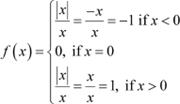
The given function f is defined at all the points of the real line. Let c be a point on the real line.
Case I:
Therefore, f is continuous at all points x < 0 Case II:
If c = 0, then the left hand limit of f at x = 0 is,
The right hand limit of f at x = 0 is,
It is observed that the left and right hand limit of f at x = 0 do not coincide. Therefore, f is not continuous at x = 0
Case III:
![]()
Therefore, f is continuous at all points x, such that x > 0 Hence, x = 0 is the only point of discontinuity of f.
Question 9:
Find all points of discontinuity of f, where f is defined by
 |
Answer
 |
It is known that,
![]()
Therefore, the given function can be rewritten as
 |
Let c be any real number.
Then, ![]() Also,
Also, ![]()
Therefore, the given function is a continuous function. Hence, the given function has no point of discontinuity.
Question 10:
Find all points of discontinuity of f, where f is defined by
![]()
Answer
The given function f is defined at all the points of the real line. Let c be a point on the real line.
Case I:
 |
Therefore, f is continuous at all points x, such that x < 1 Case II:
![]()
The left hand limit of f at x = 1 is,
The right hand limit of f at x = 1 is,
 |
Therefore, f is continuous at x = 1 Case III:
![]()
Therefore, f is continuous at all points x, such that x > 1 Hence, the given function f has no point of discontinuity.
Question 11:
Find all points of discontinuity of f, where f is defined by
![]()
Answer
The given function f is defined at all the points of the real line. Let c be a point on the real line.
Case I:
Therefore, f is continuous at all points x, such that x < 2 Case II:
![]()
 |
Therefore, f is continuous at x = 2 Case III:

Therefore, f is continuous at all points x, such that x > 2
Thus, the given function f is continuous at every point on the real line. Hence, f has no point of discontinuity.
Question 12:
Find all points of discontinuity of f, where f is defined by
![]()
Answer
The given function f is defined at all the points of the real line. Let c be a point on the real line.
Case I:
 |
Therefore, f is continuous at all points x, such that x < 1 Case II:
If c = 1, then the left hand limit of f at x = 1 is,
The right hand limit of f at x = 1 is,
It is observed that the left and right hand limit of f at x = 1 do not coincide. Therefore, f is not continuous at x = 1
Case III:
 |
Therefore, f is continuous at all points x, such that x > 1
Thus, from the above observation, it can be concluded that x = 1 is the only point of discontinuity of f.
Question 13:
Is the function defined by
![]()
a continuous function? Answer
The given function is ![]()
The given function f is defined at all the points of the real line. Let c be a point on the real line.
Case I:
Therefore, f is continuous at all points x, such that x < 1 Case II:
![]()
The left hand limit of f at x = 1 is,
The right hand limit of f at x = 1 is,
It is observed that the left and right hand limit of f at x = 1 do not coincide. Therefore, f is not continuous at x = 1
Case III:
Therefore, f is continuous at all points x, such that x > 1
Thus, from the above observation, it can be concluded that x = 1 is the only point of discontinuity of f.
Question 14:
Discuss the continuity of the function f, where f is defined by
 |
Answer
 The given function is
The given function is
The given function is defined at all points of the interval [0, 10]. Let c be a point in the interval [0, 10].
Case I:
 |
Therefore, f is continuous in the interval [0, 1). Case II:
![]()
The left hand limit of f at x = 1 is,
The right hand limit of f at x = 1 is,
It is observed that the left and right hand limits of f at x = 1 do not coincide. Therefore, f is not continuous at x = 1
Case III:
 |
Therefore, f is continuous at all points of the interval (1, 3). Case IV:
![]()
The left hand limit of f at x = 3 is,
The right hand limit of f at x = 3 is,
It is observed that the left and right hand limits of f at x = 3 do not coincide. Therefore, f is not continuous at x = 3
Case V:
Therefore, f is continuous at all points of the interval (3, 10]. Hence, f is not continuous at x = 1 and x = 3
Question 15:
Discuss the continuity of the function f, where f is defined by
 |
Answer
 The given function is
The given function is
The given function is defined at all points of the real line. Let c be a point on the real line.
Case I:
 |
Therefore, f is continuous at all points x, such that x < 0
Case II:
The left hand limit of f at x = 0 is,
The right hand limit of f at x = 0 is,
 |
Therefore, f is continuous at x = 0 Case III:

Therefore, f is continuous at all points of the interval (0, 1). Case IV:
The left hand limit of f at x = 1 is,
The right hand limit of f at x = 1 is,
It is observed that the left and right hand limits of f at x = 1 do not coincide. Therefore, f is not continuous at x = 1
Case V:
 |
Therefore, f is continuous at all points x, such that x > 1 Hence, f is not continuous only at x = 1
Question 16:
Discuss the continuity of the function f, where f is defined by

Answer
 |
The given function is defined at all points of the real line. Let c be a point on the real line.
Case I:
 |
Therefore, f is continuous at all points x, such that x < −1 Case II:
![]()
The left hand limit of f at x = −1 is,
The right hand limit of f at x = −1 is,
Therefore, f is continuous at x = −1 Case III:

Therefore, f is continuous at all points of the interval (−1, 1). Case IV:
![]()
The left hand limit of f at x = 1 is,
The right hand limit of f at x = 1 is,
Therefore, f is continuous at x = 2 Case V:
![]()
Therefore, f is continuous at all points x, such that x > 1
Thus, from the above observations, it can be concluded that f is continuous at all points of the real line.
Question 17:
Find the relationship between a and b so that the function f defined by
is continuous at x = 3. Answer
![]()
If f is continuous at x = 3, then
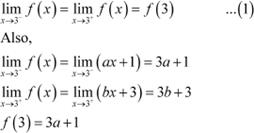
Therefore, from (1), we obtain
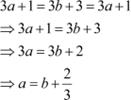 |
Therefore, the required relationship is given by, ![]()
Question 18:
![]() For what value of is
the function defined
by
For what value of is
the function defined
by
continuous at x = 0? What about continuity at x = 1? Answer
![]() The given function is
The given function is
If f is continuous at x = 0, then
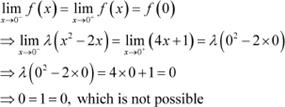 |
Therefore, there is no value of λ for which f is continuous at x = 0
At x = 1,
f (1) = 4x + 1 = 4 × 1 + 1 = 5
 |
Therefore, for any values of λ, f is continuous at x = 1
Question 19:
Show that the function defined
by ![]() is discontinuous at all integral
point. Here
is discontinuous at all integral
point. Here ![]() denotes the greatest integer
less than or equal to x.
denotes the greatest integer
less than or equal to x.
Answer
The given function is ![]()
It is evident that g is defined at all integral points. Let n be an integer.
Then,
The left hand limit of f at x = n is,
The right hand limit of f at x = n is,
It is observed that the left and right hand limits of f at x = n do not coincide. Therefore, f is not continuous at x = n
Hence, g is discontinuous at all integral points.
Question 20:
Is the function
defined by ![]() continuous
at x = p? Answer
continuous
at x = p? Answer
![]() The given function is
The given function is
It is evident that f is defined at x = p
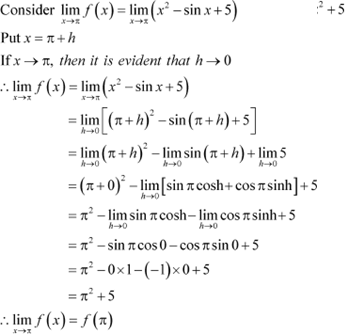 |
Therefore, the given function f is continuous at x = π
Question 21:
Discuss the continuity of the following functions.
(a) f (x) = sin x + cos x
(b) f (x) = sin x − cos x
(c) f (x) = sin x × cos x Answer
It is known that if g and h are two continuous functions, then
![]() are also continuous.
are also continuous.
It has to proved first that g (x) = sin x and h (x) = cos x are continuous functions. Let g (x) = sin x
It is evident that g (x) = sin x is defined for every real number. Let c be a real number. Put x = c + h
If x → c, then h → 0
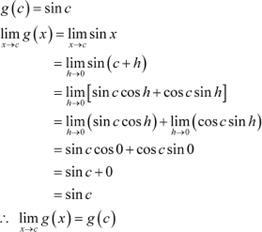
Therefore, g is a continuous function. Let h (x) = cos x
It is evident that h (x) = cos x is defined for every real number. Let c be a real number. Put x = c + h
If x → c, then h → 0
h (c) = cos c
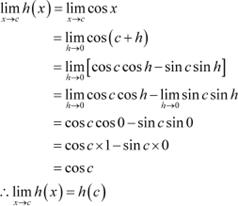 |
Therefore, h is a continuous function.
Therefore, it can be concluded that
(a) f (x) = g (x) + h (x) = sin x + cos x is a continuous function
(b) f (x) = g (x) − h (x) = sin x − cos x is a continuous function
(c) f (x) = g (x) × h (x) = sin x × cos x is a continuous function
Question 22:
Discuss the continuity of the cosine, cosecant, secant and cotangent functions, Answer
It is known that if g and h are two continuous functions, then
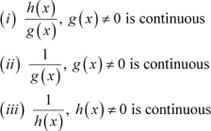 |
It has to be proved first that g (x) = sin x and h (x) = cos x are continuous functions. Let g (x) = sin x
It is evident that g (x) = sin x is defined for every real number. Let c be a real number. Put x = c + h
![]()
![]() If x c, then h 0
If x c, then h 0
 |
Therefore, g is a continuous function. Let h (x) = cos x
It is evident that h (x) = cos x is defined for every real number. Let c be a real number. Put x = c + h
![]()
![]() If x c, then h 0
If x c, then h 0
h (c) = cos c

 |
Therefore, h (x) = cos x is continuous function. It can be concluded that,
Therefore, cosecant is continuous except at x = np, n Î Z
 |
 |
Therefore, secant is continuous except at
Therefore, cotangent is continuous except at x = np, n Î Z
Question 23:
Find the points of discontinuity of f, where
 |
Answer
 |
It is evident that f is defined at all points of the real line. Let c be a real number.
Case I:
 |
Therefore, f is continuous at all points x, such that x < 0 Case II:

Therefore, f is continuous at all points x, such that x > 0 Case III:
The left hand limit of f at x = 0 is,
The right hand limit of f at x = 0 is,
 |
Therefore, f is continuous at x = 0
From the above observations, it can be concluded that f is continuous at all points of the real line.
Thus, f has no point of discontinuity.
Question 24:
Determine if f defined by
 |
is a continuous function? Answer

It is evident that f is defined at all points of the real line. Let c be a real number.
Case I:
 |
Therefore, f is continuous at all points x ≠ 0 Case II:
![]()

Therefore, f is continuous at x = 0
From the above observations, it can be concluded that f is continuous at every point of the real line.
Thus, f is a continuous function.
Question 25:
Examine the continuity of f, where f is defined by
Answer
It is evident that f is defined at all points of the real line. Let c be a real number.
Case I:

 |
Therefore, f is continuous at all points x, such that x ≠ 0 Case II:
Therefore, f is continuous at x = 0
From the above observations, it can be concluded that f is continuous at every point of the real line.
Thus, f is a continuous function.
Question 26:
Find the values of k so that the function f is continuous at the indicated point.
 |
Answer
 |
The given function f is continuous at ![]() , if f is defined
at
, if f is defined
at ![]() and if the value of
the f
and if the value of
the f
![]()
![]() at equals the limit of f at .
at equals the limit of f at .

Therefore, the required value of k is 6.
Question 27:
Find the values of k so that the function f is continuous at the indicated point.
Answer
The given function is ![]()
The given function f is continuous at x = 2, if f is defined at x = 2 and if the value of f at
x = 2 equals the limit of f at x = 2
![]() It is evident that f is
defined at x = 2 and
It is evident that f is
defined at x = 2 and
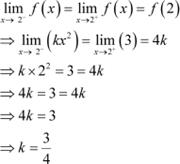
![]() Therefore, the required value of .
Therefore, the required value of .
Question 28:
Find the values of k so that the function f is continuous at the indicated point.
Answer
The given function is ![]()
The given function f is continuous at x = p, if f is defined at x = p and if the value of f at
x = p equals the limit of f at x = p
 |
It is evident that f is defined at x = p and
![]() Therefore, the required value of
Therefore, the required value of
Question 29:
Find the values of k so that the function f is continuous at the indicated point.
Answer
The given function f is continuous at x = 5, if f is defined at x = 5 and if the value of f at
x = 5 equals the limit of f at x = 5
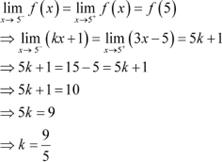 |
It is evident that f is defined at x = 5 and
Therefore, the required value of ![]()
Question 30:
Find the values of a and b such that the function defined by
 |
is a continuous function.
Answer
 |
It is evident that the given function f is defined at all points of the real line. If f is a continuous function, then f is continuous at all real numbers.
 |
In particular, f is continuous at x = 2 and x = 10 Since f is continuous at x = 2, we obtain
Since f is continuous at x = 10, we obtain
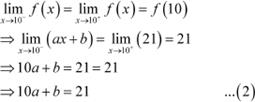 |
On subtracting equation (1) from equation (2), we obtain 8a = 16
⇒ a = 2
By putting a = 2 in equation (1), we obtain 2 × 2 + b = 5
⇒ 4 + b = 5
⇒ b = 1
Therefore, the values of a and b for which f is a continuous function are 2 and 1 respectively.
Question 31:
Show that the function defined by f (x) = cos (x2) is a continuous function. Answer
The given function is f (x) = cos (x2)
This function f is defined for every real number and f can be written as the composition of two functions as,
f = g o h, where g (x) = cos x and h (x) = x2
It has to be first proved that g (x) = cos x and h (x) = x2 are continuous functions. It is evident that g is defined for every real number.
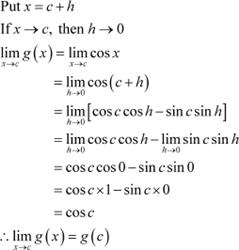 |
Let c be a real number. Then, g (c) = cos c
Therefore, g (x) = cos x is continuous function.
h (x) = x2
 |
Clearly, h is defined for every real number. Let k be a real number, then h (k) = k2
Therefore, h is a continuous function.
It is known that for real valued functions g and h,such that (g o h) is defined at c, if g is continuous at c and if f is continuous at g (c), then (f o g) is continuous at c.
Therefore, ![]() is a continuous function.
is a continuous function.
Question 32:
Show that the function defined
by ![]() is a continuous function.
Answer
is a continuous function.
Answer
The given function is ![]()
This function f is defined for every real number and f can be written as the composition of two functions as,
f = g o h,
where ![]()
It has to be first proved that ![]() are continuous functions.
are continuous functions.

Clearly, g is defined for all real numbers. Let c be a real number.
Case I:
 |
 |
Therefore, g is continuous at all points x, such that x < 0 Case II:
Therefore, g is continuous at all points x, such that x > 0 Case III:
![]()
 |
Therefore, g is continuous at x = 0
From the above three observations, it can be concluded that g is continuous at all points.
h (x) = cos x
It is evident that h (x) = cos x is defined for every real number. Let c be a real number. Put x = c + h
If x → c, then h → 0
h (c) = cos c
 |
Therefore, h (x) = cos x is a continuous function.
It is known that for real valued functions g and h,such that (g o h) is defined at c, if g is continuous at c and if f is continuous at g (c), then (f o g) is continuous at c.
Therefore, ![]() is a continuous function.
is a continuous function.
Question 33:
Examine that
This function f is defined for every real number and f can be written as the composition of two functions as,
f = g o h,
where ![]()
It has to be proved
first that ![]() are continuous functions.
are continuous functions.

Clearly, g is defined for all real numbers. Let c be a real number.
Case I:
 |
Therefore, g is continuous at all points x, such that x < 0 Case II:

Therefore, g is continuous at all points x, such that x > 0 Case III:

Therefore, g is continuous at x = 0
From the above three observations, it can be concluded that g is continuous at all points.
h (x) = sin x
It is evident that h (x) = sin x is defined for every real number. Let c be a real number. Put x = c + k
If x → c, then k → 0
h (c) = sin c
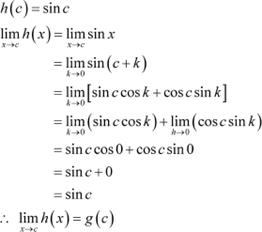 |
Therefore, h is a continuous function.
It is known that for real valued functions g and h,such that (g o h) is defined at c, if g is continuous at c and if f is continuous at g (c), then (f o g) is continuous at c.
Therefore, ![]() is a continuous function.
is a continuous function.
Question 34:
Find all the points
of discontinuity of f defined by ![]() . Answer
. Answer
![]() The given function is
The given function is
The two functions, g and h, are defined as
Then, f = g − h
The continuity of g and h is examined first.
 |
Clearly, g is defined for all real numbers. Let c be a real number.
Case I:
 |
Therefore, g is continuous at all points x, such that x < 0 Case II:

 |
Therefore, g is continuous at all points x, such that x > 0 Case III:
Therefore, g is continuous at x = 0
From the above three observations, it can be concluded that g is continuous at all points.
 |
Clearly, h is defined for every real number.
Let c be a real number. Case I:

 |
Therefore, h is continuous at all points x, such that x < −1 Case II:
Therefore, h is continuous at all points x, such that x > −1 Case III:
![]()
 |
Therefore, h is continuous at x = −1
From the above three observations, it can be concluded that h is continuous at all points of the real line.
g and h are continuous functions. Therefore, f = g − h is also a continuous function. Therefore, f has no point of discontinuity.
Exercise 5.2
Question 1:
Differentiate the functions with respect to x.
Answer
 |
Thus, f is a composite of two functions.
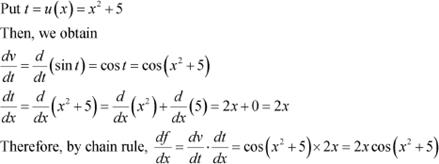 |
Alternate method
 |
Question 2:
Differentiate the functions with respect to x.
Answer
Thus, f is a composite function of two functions. Put t = u (x) = sin x

By chain rule, ![]()
Alternate method
Question 3:
Differentiate the functions with respect to x.
Answer
Thus, f is a composite function of two functions, u and v. Put t = u (x) = ax + b

Hence, by chain rule, we obtain
Alternate method
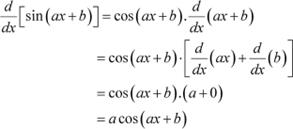 |
Question 4:
Differentiate the functions with respect to x.
Answer
 |
Thus, f is a composite function of three functions, u, v, and w.
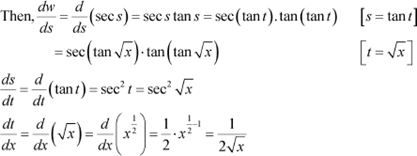 |
Hence, by chain rule, we obtain

Alternate method
 |
Question 5:
Differentiate the functions with respect to x.
Answer
![]() The given function is , where
g (x) = sin (ax
+ b) and
The given function is , where
g (x) = sin (ax
+ b) and
h (x) = cos (cx + d)
 |
∴ g is a composite function of two functions, u and v.
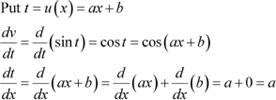 |
Therefore, by chain rule, we obtain
 |
∴h is a composite function of two functions, p and q.
Put y = p (x) = cx + d
 |
Therefore, by chain rule, we obtain

Question 6:
Differentiate the functions with respect to x.
Answer
The given function is ![]()
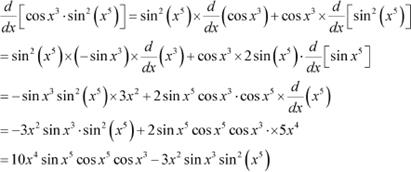 |
Question 7:
Differentiate the functions with respect to x.
Answer
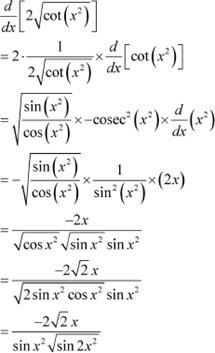
Question 8:
Differentiate the functions with respect to x.
Answer
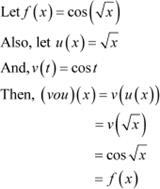 |
Clearly, f is a composite function of two functions, u and v, such that

By using chain rule, we obtain
 |
Alternate method
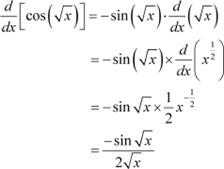 |
Question 9:
Prove that the function f given by
![]() is notdifferentiable at x = 1. Answer
is notdifferentiable at x = 1. Answer
![]() The given function is
The given function is
It is known that a function f is differentiable at a point x = c in its domain if both
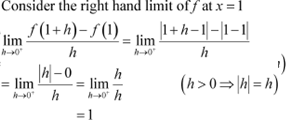 |
Since the left and right hand limits of f at x = 1 are not equal, f is not differentiable at x
= 1
Question 10:
Prove that the greatest
integer function defined
by![]() is not differentiable at x = 1 and x = 2.
is not differentiable at x = 1 and x = 2.
Answer
The given function f is ![]()
It is known that a function f is differentiable at a point x = c in its domain if both
![]() are finite and equal.
are finite and equal.
To check the differentiability of the given function at x = 1, consider the left hand limit of
f at x = 1

Since the left and right hand limits of f at x = 1 are not equal, f is not differentiable at
x = 1
To check the differentiability of the given function at x = 2, consider the left hand limit of f at x = 2
Since the left and right hand limits of f at x = 2 are not equal, f is not differentiable at x
= 2
Exercise 5.3
![]() Question 1:
Question 1:
Find :
Answer
The given relationship is ![]()
Differentiating this relationship with respect to x, we obtain
Question 2:
Find ![]()
Answer
The given relationship is ![]()
Differentiating this relationship with respect to x, we obtain
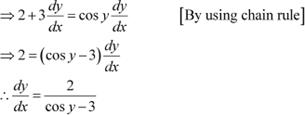
Question 3:
Find ![]()
Answer
The given relationship is ![]()
Differentiating this relationship with respect to x, we obtain
Using chain rule, we obtain ![]() and
and ![]() From (1) and (2), we obtain
From (1) and (2), we obtain
Question 4:
![]() Find
Find
Answer
The given relationship is ![]()
Differentiating this relationship with respect to x, we obtain
Question 5:
Find ![]()
Answer
The given relationship is ![]()
Differentiating this relationship with respect to x, we obtain
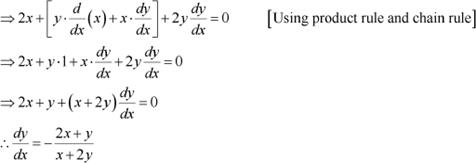
Question 6:
Find ![]()
Answer
The given relationship is
Question 7:
![]() Find
Find
Answer
The given relationship is ![]()
Differentiating this relationship with respect to x, we obtain
Using chain rule, we obtain
From (1), (2), and (3), we obtain
Question 8:
Find ![]()
Answer
The given relationship is ![]()
Differentiating this relationship with respect to x, we obtain
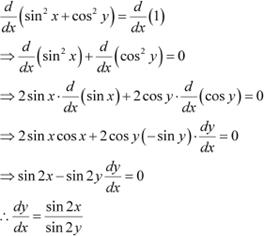
Question 9:
Find ![]()
Answer
The given relationship is ![]()
Differentiating this relationship with respect to x, we obtain
The function, ![]() , is of the form of
, is of the form of ![]() . Therefore, by quotient rule, we obtain
. Therefore, by quotient rule, we obtain

![]() Also,
Also,
From (1), (2), and (3), we obtain
Question 10:
Find ![]()
Answer
![]() The given relationship is
The given relationship is

![]() It is known that,
It is known that,
Comparing equations (1) and (2), we obtain
Differentiating this relationship with respect to x, we obtain
Question 11:
Find ![]()
Answer
The given relationship is,
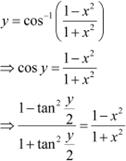
On comparing L.H.S. and R.H.S. of the above relationship, we obtain
Differentiating this relationship with respect to x, we obtain
Question 12:
Find ![]()
Answer
![]() The given relationship is
The given relationship is
![]()
Differentiating this relationship with respect to x, we obtain
Using chain rule, we obtain
From (1), (2), and (3), we obtain

Alternate method
⇒ ![]()
Differentiating this relationship with respect to x, we obtain

Question 13:
Find ![]()
Answer
The given relationship is ![]()
Differentiating this relationship with respect to x, we obtain

Question 14:
Find ![]()
Answer
The given relationship is ![]()
Differentiating this relationship with respect to x, we obtain

Question 15:
Find ![]()
Answer
![]() The given relationship is
The given relationship is

Differentiating this relationship with respect to x, we obtain
Exercise 5.4
Question 1:
Differentiate the following w.r.t. x:
Answer
Let ![]()
By using the quotient rule, we obtain
Question 2:
Differentiate the following w.r.t. x:
Answer
Let ![]()
By using the chain rule, we obtain

Question 2:
Show that the function given by f(x) = e2x is strictly increasing on R. Answer
Let
Hence, f is strictly increasing on R.
Question 3:
Differentiate the following w.r.t. x:
Answer Let ![]()
By using the chain rule, we obtain
Question 4:
Differentiate the following w.r.t. x:
Answer
Let ![]()
By using the chain rule, we obtain
Question 5:
Differentiate the following w.r.t. x:
Answer
Let ![]()
By using the chain rule, we obtain
Question 6:
Differentiate the following w.r.t. x:
Answer
Question 7:
Differentiate the following w.r.t. x:
Answer Let ![]() Then,
Then, ![]()
By differentiating this relationship with respect to x, we obtain
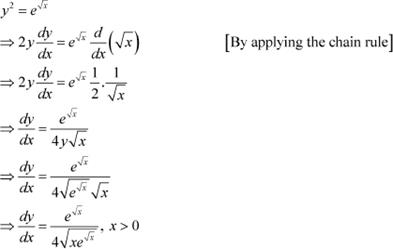
Question 8:
Differentiate the following w.r.t. x:
Answer
Let ![]()
By using the chain rule, we obtain
![]() , x >
1
, x >
1
Question 9:
Differentiate the following w.r.t. x:
Answer
Let ![]()
By using the quotient rule, we obtain
Question 10:
Differentiate the following w.r.t. x:
Answer
Let ![]()
By using the chain rule, we obtain
Exercise 5.5
Question 1:
Differentiate the function with respect to x.
Answer
Taking logarithm on both the sides, we obtain
Differentiating both sides with respect to x, we obtain
Question 2:
Differentiate the function with respect to x.
Answer
Taking logarithm on both the sides, we obtain
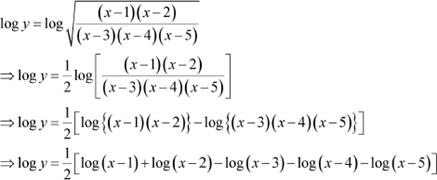
Differentiating both sides with respect to x, we obtain
Question 3:
Differentiate the function with respect to x.
Answer
Taking logarithm on both the sides, we obtain
Differentiating both sides with respect to x, we obtain
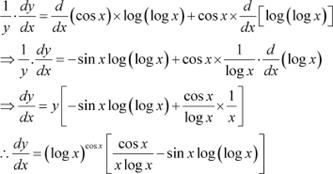
Question 4:
Differentiate the function with respect to x.
Answer
u = xx
Taking logarithm on both the sides, we obtain
Differentiating both sides with respect to x, we obtain
v = 2sin x
Taking logarithm on both the sides with respect to x, we obtain
![]()
Differentiating both sides with respect to x, we obtain
Question 5:
Differentiate the function with respect to x.
Answer
Taking logarithm on both the sides, we obtain
Differentiating both sides with respect to x, we obtain
Question 6:
Differentiate the function with respect to x.
Answer
Differentiating both sides with respect to x, we obtain
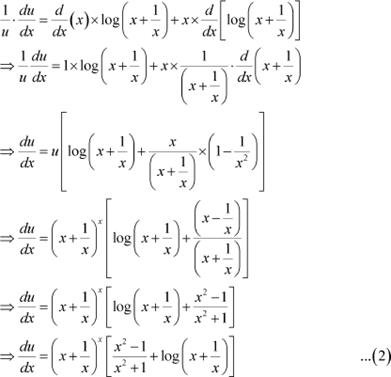
Differentiating both sides with respect to x, we obtain
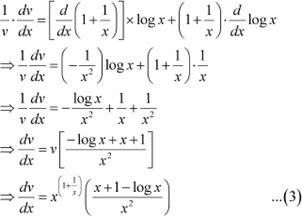
Therefore, from (1), (2), and (3), we obtain
Question 7:
Differentiate the function with respect to x.
Answer
u = (log x)x
Differentiating both sides with respect to x, we obtain
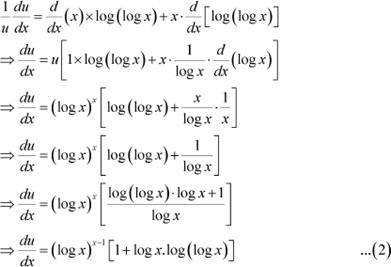
Differentiating both sides with respect to x, we obtain
Therefore, from (1), (2), and (3), we obtain
Question 8:
Differentiate the function with respect to x.
![]()
Answer
Differentiating both sides with respect to x, we obtain
Therefore, from (1), (2), and (3), we obtain
Question 9:
Differentiate the function with respect to x.
Answer
Differentiating both sides with respect to x, we obtain
Differentiating both sides with respect to x, we obtain
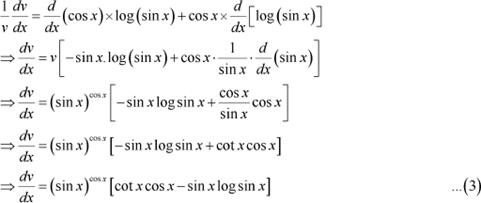
From (1), (2), and (3), we obtain
Question 10:
Differentiate the function with respect to x.
Answer
Differentiating both sides with respect to x, we obtain
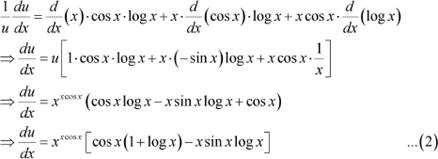
Differentiating both sides with respect to x, we obtain
From (1), (2), and (3), we obtain
Question 11:
Differentiate the function with respect to x.
Answer
Differentiating both sides with respect to x, we obtain
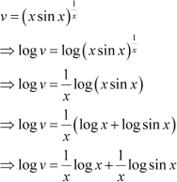
Differentiating both sides with respect to x, we obtain
From (1), (2), and (3), we obtain
Question 12:
![]() Find of function.
Find of function.
![]()
Answer
The
given function is ![]() Let xy = u and yx = v
Let xy = u and yx = v
Then, the function becomes u + v = 1
Differentiating both sides with respect to x, we obtain
Differentiating both sides with respect to x, we obtain
From (1), (2), and (3), we obtain
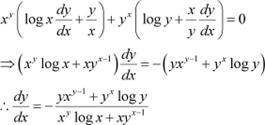
Question 13:
![]() Find
Find ![]() of function.
Answer
of function.
Answer
The given function is ![]()
Taking logarithm on both the sides, we obtain
Differentiating both sides with respect to x, we obtain
Question 14:
![]() Find of function.
Find of function.
![]()
Answer
The given function is ![]()
Taking logarithm on both the sides, we obtain
Differentiating both sides, we obtain
Question 15:
![]() Find
Find ![]() of function.
Answer
of function.
Answer
The given function is ![]()
Taking logarithm on both the sides, we obtain
Differentiating both sides with respect to x, we obtain
Question 16:
Find the derivative of the function
given by ![]() and hence
find
and hence
find ![]() .
.
Answer
The given relationship is
Differentiating both sides with respect to x, we obtain

Question 17:
Differentiate ![]() in three ways mentioned below
in three ways mentioned below
(i) By using product rule.
(ii) By expanding the product to obtain a single polynomial. (iii By logarithmic differentiation.
Do they all give the same answer?
![]() Answer (i)
Answer (i)

![]() (ii)
(ii)
(iii)
![]()
Taking logarithm on both the sides, we obtain
Differentiating both sides with respect to x, we obtain

From the above three
observations, it can be concluded that all the results of ![]() are same.
are same.
Question 18:
If u, v and w are functions of x, then show that
in two ways-first by repeated application of product rule, second by logarithmic differentiation.
Answer
Let ![]()
By applying product rule, we obtain

![]() By taking
logarithm on both sides of the equation , we obtain
By taking
logarithm on both sides of the equation , we obtain
Differentiating both sides with respect to x, we obtain
Exercise 5.6
Question 1:
If x and y are connected parametrically by the equation, without eliminating the
![]() .
.
Answer
The given equations are ![]()
Question 2:
If x and y are connected parametrically by the equation, without eliminating the
parameter, find ![]() .
.
x = a cos θ, y = b cos θ
Answer
The given equations are x = a cos θ and y = b cos θ
Question 3:
If x and y are connected parametrically by the equation, without eliminating the
parameter, find ![]() .
.
x = sin t, y = cos 2t Answer
The given equations are x = sin t and y = cos 2t
Question 4:
If x and y are connected parametrically by the equation, without eliminating the
parameter, find
Answer
![]() The given equations are
The given equations are
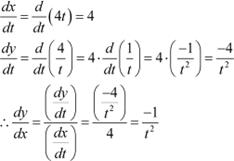
Question 5:
![]() If x and y are connected
parametrically by the equation, without
eliminating the parameter, find
If x and y are connected
parametrically by the equation, without
eliminating the parameter, find ![]()
Answer
The given equations are ![]()
Question 6:
Answer
The given equations are
Question 7:
![]() If x and y are connected
parametrically by the equation, without
eliminating the parameter, find
If x and y are connected
parametrically by the equation, without
eliminating the parameter, find ![]()
Answer
![]() The given equations are
The given equations are
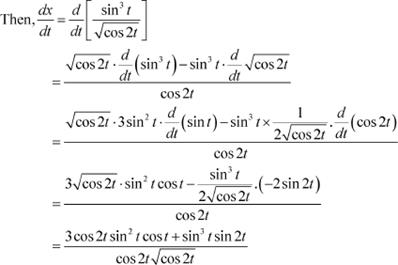
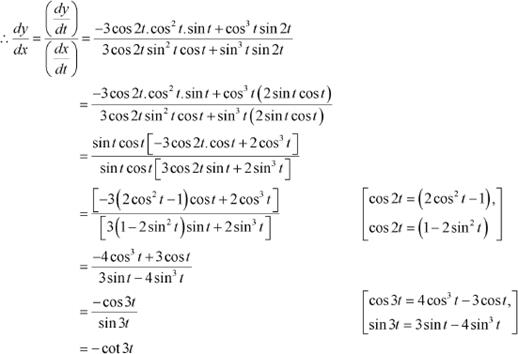
Question 8:
If x and y are connected parametrically by the equation, without eliminating the
![]() parameter, find
parameter, find
.
Answer
![]() The given equations are
The given equations are

Question 9:
If x and y are connected parametrically by the equation, without eliminating the
![]() parameter, find
parameter, find
.
Answer
The given equations are ![]()
Question 10:
If x and y are connected parametrically by the equation, without eliminating the
![]() parameter, find
parameter, find
.
Answer
![]() The given equations are
The given equations are
![]() Question 11:
Question 11:
If Answer
The given equations are ![]()

Hence, proved.
Exercise 5.7
Question 1:
Find the second order derivatives of the function.
Answer
Let
Question 2:
Find the second order derivatives of the function.
Answer
Let
Question 3:
Find the second order derivatives of the function.
Answer
![]() Let Then,
Let Then,
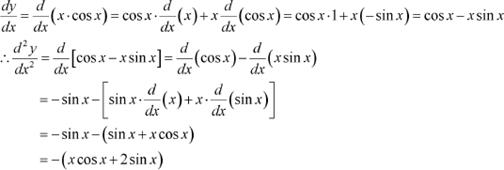
Question 4:
Find the second order derivatives of the function.
Answer
Let
Question 5:
Find the second order derivatives of the function.
Answer
Let ![]() Then,
Then,
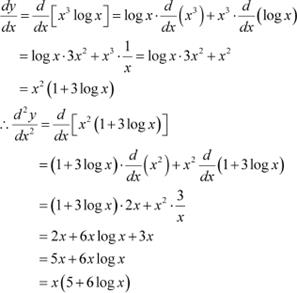
Question 6:
Find the second order derivatives of the function.
Answer
![]() Let
Let ![]()
Then,
Question 7:
Find the second order derivatives of the function.
Answer
Let
Question 8:
Find the second order derivatives of the function.
Answer
Let ![]() Then,
Then,
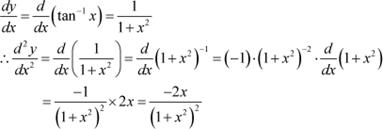
Question 9:
Find the second order derivatives of the function.
Answer
Let
Question 10:
Find the second order derivatives of the function.
Answer
Let ![]() Then,
Then,

Question 11:
![]() If , prove that
If , prove that ![]()
Answer
It is given that, ![]() Then,
Then,
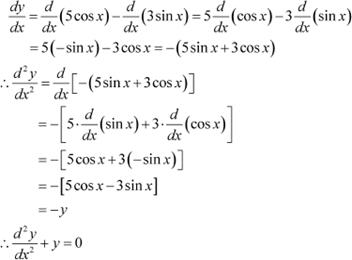
Hence, proved.
Question 12:
![]() If find
If find ![]() in terms of y alone. Answer
in terms of y alone. Answer
It is given that, ![]() Then,
Then,
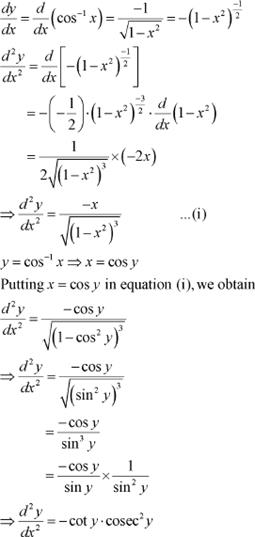
Question 13:
If ![]() , show that
, show that ![]()
Answer
It is given that, ![]() Then,
Then,
![]()
Hence, proved.
Question 14:
![]()
![]() If show that
If show that
Answer
It is given that,
Hence, proved.
Question 15:
![]() If , show that
If , show that ![]()
Answer
It is given that, ![]() Then,
Then,
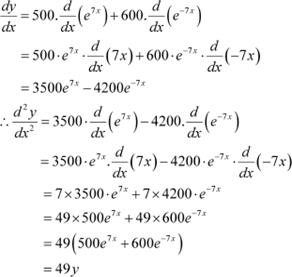
Hence, proved.
Question 16:
![]() If , show that
If , show that
![]() Answer
Answer
The given relationship is
Taking logarithm on both the sides, we obtain
Differentiating this relationship with respect to x, we obtain
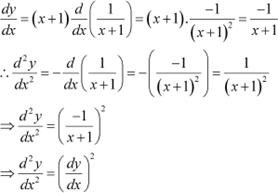
Hence, proved.
Question 17:
If ![]() , show that
, show that ![]()
Answer
The given relationship is
Hence, proved.
Exercise 5.8
Question 1:
![]() Verify Rolle’s
Theorem for the function Answer
Verify Rolle’s
Theorem for the function Answer
The given function,
∴ f (−4) = f (2) = 0
⇒ The value of f (x) at −4 and 2 coincides.
Rolle’s Theorem states that there is a point c ∈ (−4, 2) such that ![]()
Hence, Rolle’s Theorem is verified for the given function.
Question 2:
Examine if Rolle’s Theorem is applicable to any of the following functions. Can you say some thing about the converse of Rolle’s Theorem from these examples?
(i) ![]()
(ii) ![]()
(iii) ![]() Answer
Answer
By Rolle’s Theorem, for a function
![]() , if
, if
(a) f is continuous on [a, b]
(b) f is differentiable on (a, b)
(c) f (a) = f (b)
then, there exists some c ∈ (a, b) such that ![]()
Therefore, Rolle’s Theorem is not applicable to those functions that do not satisfy any of the three conditions of the hypothesis.
(i) ![]()
It is evident that the given function f (x) is not continuous at every integral point. In particular, f(x) is not continuous at x = 5 and x = 9
⇒ f (x) is not continuous in [5, 9].
The differentiability of f in (5, 9) is checked as follows.
Let n be an integer such that n ∈ (5, 9).
Since the left and right hand limits of f at x = n are not equal, f is not differentiable at x
= n
∴f is not differentiable in (5, 9).
It is observed that f does not satisfy all the conditions of the hypothesis of Rolle’s Theorem.
Hence, Rolle’s Theorem
is not applicable for ![]() . (ii)
. (ii) ![]()
It is evident that the given function f (x) is not continuous at every integral point. In particular, f(x) is not continuous at x = −2 and x = 2
⇒ f (x) is not continuous in [−2, 2].
The differentiability of f in (−2, 2) is checked as follows.
Let n be an integer such that n ∈ (−2, 2).
Since the left and right hand limits of f at x = n are not equal, f is not differentiable at x
= n
∴f is not differentiable in (−2, 2).
It is observed that f does not satisfy all the conditions of the hypothesis of Rolle’s Theorem.
Hence, Rolle’s Theorem
is not applicable for ![]() . (iii)
. (iii) ![]()
It is evident that f, being a polynomial function, is continuous in [1, 2] and is differentiable in (1, 2).
∴f (1) ≠ f (2)
It is observed that f does not satisfy a condition of the hypothesis of Rolle’s Theorem.
Hence, Rolle’s Theorem is not applicable for ![]() .
.
Question 3:
If ![]() is a differentiable
function and if
is a differentiable
function and if ![]() does
not vanish anywhere, then prove that
does
not vanish anywhere, then prove that ![]() .
.
Answer
It is given that ![]() is a differentiable function.
is a differentiable function.
Since every differentiable function is a continuous function, we obtain
(a) f is continuous on [−5, 5].
(b) f is differentiable on (−5, 5).
Therefore, by the Mean Value Theorem, there exists c ∈ (−5, 5) such that
It is also given that
Hence, proved.
Question 4:
![]()
![]() Verify Mean Value Theorem,
if
Verify Mean Value Theorem,
if ![]() in the interval
in the interval ![]() , where and
, where and
Answer
The given function is ![]()
f, being a polynomial function, is continuous in [1, 4] and is differentiable in (1, 4) whose derivative is 2x − 4.
Mean Value Theorem states
that there is a point
c ∈ (1, 4) such that ![]()
Hence, Mean Value Theorem is verified for the given function.
Question 5:
Verify Mean Value Theorem,
if ![]() in the interval [a, b], where a = 1 and
in the interval [a, b], where a = 1 and
b =
3. Find all ![]() for which
for which ![]() Answer
Answer
The given function f is ![]()
f, being a polynomial function, is continuous in [1, 3] and is differentiable in (1, 3) whose derivative is 3x2 − 10x − 3.
![]() Mean Value Theorem states
that there exist a point c ∈ (1, 3) such that
Mean Value Theorem states
that there exist a point c ∈ (1, 3) such that
Hence, Mean Value Theorem
is verified for the given
function and ![]() is the only point for which
is the only point for which ![]()
Question 6:
Examine the applicability of Mean Value Theorem for all three functions given in the above exercise 2.
Answer
Mean Value Theorem states
that for a function ![]() , if
, if
(a) f is continuous on [a, b]
(b) f is differentiable on (a, b)
then, there exists some c ∈ (a, b) such that ![]()
Therefore, Mean Value Theorem is not applicable to those functions that do not satisfy any of the two conditions of the hypothesis.
![]() (i)
(i)
It is evident that the given function f (x) is not continuous at every integral point. In particular, f(x) is not continuous at x = 5 and x = 9
⇒ f (x) is not continuous in [5, 9].
The differentiability of f in (5, 9) is checked as follows.
Let n be an integer such that n ∈ (5, 9).
Since the left and right hand limits of f at x = n are not equal, f is not differentiable at x
= n
∴f is not differentiable in (5, 9).
It is observed that f does not satisfy all the conditions of the hypothesis of Mean Value Theorem.
Hence, Mean Value Theorem
is not applicable for ![]() .
.
(ii) ![]()
It is evident that the given function f (x) is not continuous at every integral point.
In particular, f(x) is not continuous at x = −2 and x = 2
⇒ f (x) is not continuous in [−2, 2].
The differentiability of f in (−2, 2) is checked as follows.
Let n be an integer such that n ∈ (−2, 2).
Since the left and right hand limits of f at x = n are not equal, f is not differentiable at x
= n
∴f is not differentiable in (−2, 2).
It is observed that f does not satisfy all the conditions of the hypothesis of Mean Value Theorem.
Hence, Mean Value Theorem
is not applicable for ![]() .
.
(iii) ![]()
It is evident that f, being a polynomial function, is continuous in [1, 2] and is differentiable in (1, 2).
It is observed that f satisfies all the conditions of the hypothesis of Mean Value Theorem.
Hence, Mean Value Theorem is applicable for
Miscellaneous Solutions
Question 1:
Answer
Using chain rule, we obtain
Question 2:
Answer
Question 3:
Answer
![]()
Taking logarithm on both the sides, we obtain
Differentiating both sides with respect to x, we obtain
Question 4:
Answer
Using chain rule, we obtain
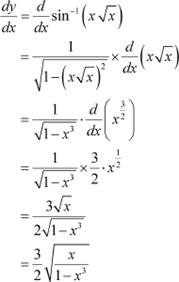
Question 5:
Answer
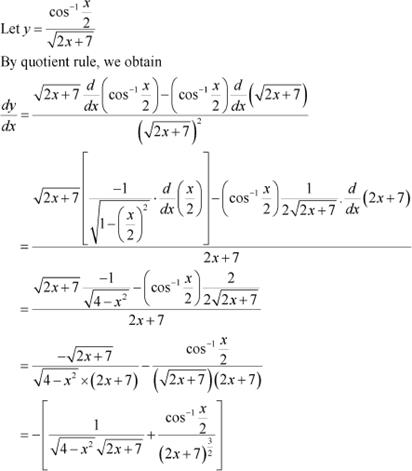
Question 6:
Answer
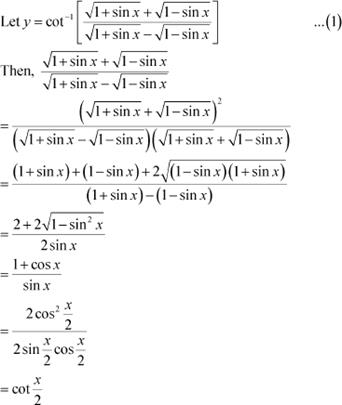
Therefore, equation (1) becomes
Question 7:
Answer
Taking logarithm on both the sides, we obtain
Differentiating both sides with respect to x, we obtain
Question 8:
By using chain rule, we obtain
Question 9:
Answer
![]()
Taking logarithm on both the sides, we obtain
Differentiating both sides with respect to x, we obtain
Question 10:
Answer
,
for some fixed ![]() and
and ![]()

Differentiating both sides with respect to x, we obtain

Differentiating both sides with respect to x, we obtain
s = aa
![]() Since a is constant, aa is also a constant.
Since a is constant, aa is also a constant.
∴
From (1), (2), (3), (4), and (5), we obtain
Question 11:
![]() , for
, for ![]()
Answer
Differentiating both sides with respect to x, we obtain
Differentiating with respect to x, we obtain
Also,
Differentiating both sides with respect to x, we obtain
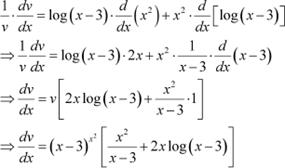
Substituting the expressions of ![]() in equation
(1), we obtain
in equation
(1), we obtain
Question 12:
Find
Question 13:
![]() Find
Find ![]() , if Answer
, if Answer

Question 14:
If
Answer
It is given that,
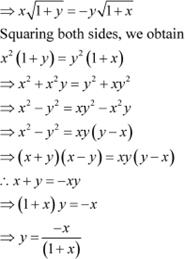
Differentiating both sides with respect to x, we obtain
Hence, proved.
Question 15:
![]()
![]() If
If ![]() , for some prove that
, for some prove that
is a constant independent of a and b
Answer
It is given that, ![]()
Differentiating both sides with respect to x, we obtain
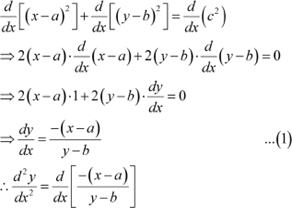
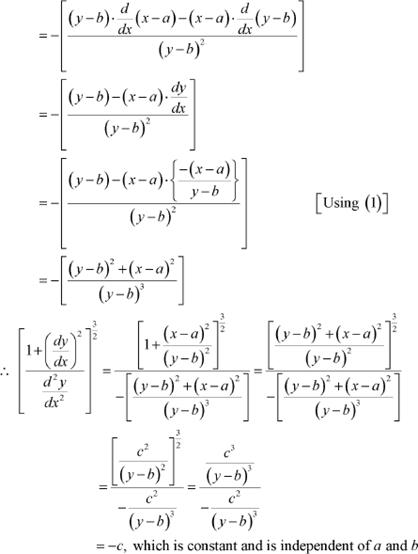
Hence, proved.
Question 16:
![]()
![]() If with prove that
If with prove that ![]() Answer
Answer
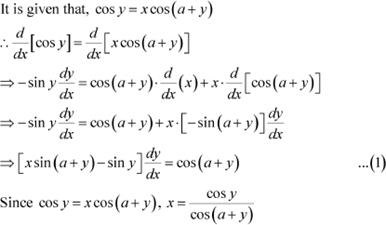
Then, equation (1) reduces to
Hence, proved.
Question 17:
![]()
![]() If and , find
If and , find ![]() Answer
Answer

Question 18:
If ![]() , show that
, show that ![]() exists for all real x, and find it. Answer
exists for all real x, and find it. Answer
It is known that, ![]() Therefore, when x ≥ 0,
Therefore, when x ≥ 0, ![]()
![]() In this case,
In this case, ![]() and hence,
and hence,
![]() When x
< 0,
When x
< 0,
![]()
![]() In this case, and hence,
In this case, and hence,
Thus, for
Question 19:
Using mathematical induction prove that ![]() for all positive integers
n. Answer
for all positive integers
n. Answer
For n = 1,
∴P(n) is true for n = 1
Let P(k) is true for some positive
integer k. That is, ![]()
It has to be proved that P(k + 1) is also true.
Thus, P(k + 1) is true whenever P (k) is true.
Therefore, by the principle of mathematical induction, the statement P(n) is true for every positive integer n.
Hence, proved.
Question 20:
Using the fact that sin (A + B) = sin A cos B + cos A sin B and the differentiation, obtain the sum formula for cosines.
Answer
Differentiating both sides with respect to x, we obtain
![]()
![]() Question 22:
Question 22:
If , prove that
Answer

![]() Thus,
Thus,
Question 23:
![]() If , show that
If , show that ![]()
Answer
![]() It is given that,
It is given that,
![]() Class XII Chapter 5 – Continuity and Differentiability Maths
Class XII Chapter 5 – Continuity and Differentiability Maths
![]()
Page 144 of 144